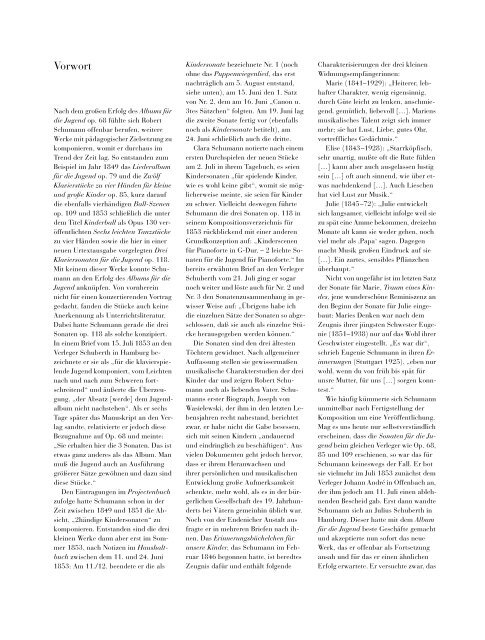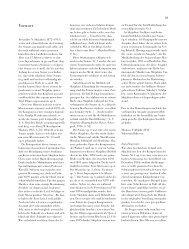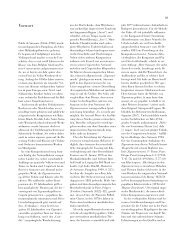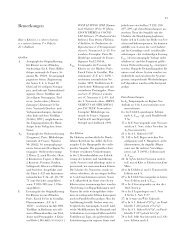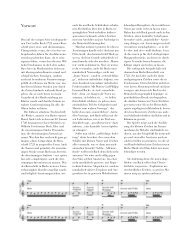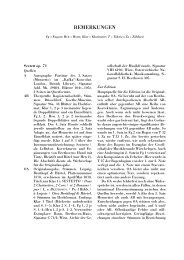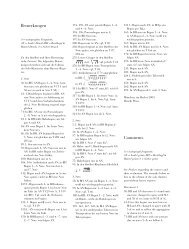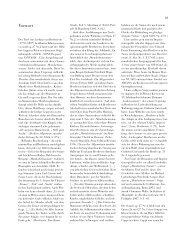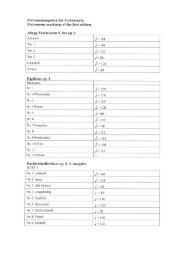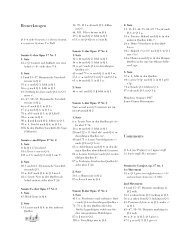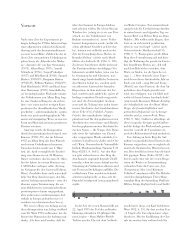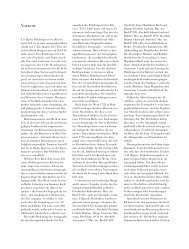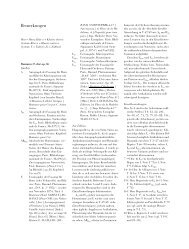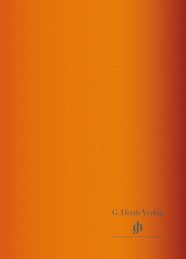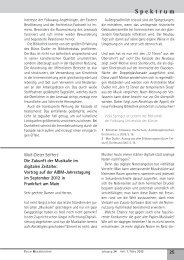Vorwort (PDF, 485 KB) - Henle Verlag
Vorwort (PDF, 485 KB) - Henle Verlag
Vorwort (PDF, 485 KB) - Henle Verlag
Create successful ePaper yourself
Turn your PDF publications into a flip-book with our unique Google optimized e-Paper software.
IV<br />
<strong>Vorwort</strong><br />
Nach dem großen Erfolg des Albums für<br />
die Jugend op. 68 fühlte sich Robert<br />
Schumann offenbar berufen, weitere<br />
Werke mit pädagogischer Zielsetzung zu<br />
komponieren, womit er durchaus im<br />
Trend der Zeit lag. So entstanden zum<br />
Beispiel im Jahr 1849 das Liederalbum<br />
für die Jugend op. 79 und die Zwölf<br />
Klavierstücke zu vier Händen für kleine<br />
und große Kinder op. 85, kurz darauf<br />
die ebenfalls vierhändigen Ball-Szenen<br />
op. 109 und 1853 schließlich die unter<br />
dem Titel Kinderball als Opus 130 veröffentlichten<br />
Sechs leichten Tanzstücke<br />
zu vier Händen sowie die hier in einer<br />
neuen Urtextausgabe vorgelegten Drei<br />
Klaviersonaten für die Jugend op. 118.<br />
Mit keinem dieser Werke konnte Schumann<br />
an den Erfolg des Albums für die<br />
Jugend anknüpfen. Von vornherein<br />
nicht für einen konzertierenden Vortrag<br />
gedacht, fanden die Stücke auch keine<br />
Anerkennung als Unterrichtsliteratur.<br />
Dabei hatte Schumann gerade die drei<br />
Sonaten op. 118 als solche konzipiert.<br />
In einem Brief vom 15. Juli 1853 an den<br />
Verleger Schuberth in Hamburg bezeichnete<br />
er sie als „für die klavierspielende<br />
Jugend komponiert, vom Leichten<br />
nach und nach zum Schweren fortschreitend“<br />
und äußerte die Überzeugung,<br />
„der Absatz [werde] dem Jugendalbum<br />
nicht nachstehen“. Als er sechs<br />
Tage später das Manuskript an den <strong>Verlag</strong><br />
sandte, relativierte er jedoch diese<br />
Bezugnahme auf Op. 68 und meinte:<br />
„Sie erhalten hier die 3 Sonaten. Das ist<br />
etwas ganz anderes als das Album. Man<br />
muß die Jugend auch an Ausführung<br />
größerer Sätze gewöhnen und dazu sind<br />
diese Stücke.“<br />
Den Eintragungen im Projectenbuch<br />
zufolge hatte Schumann schon in der<br />
Zeit zwischen 1849 und 1851 die Absicht,<br />
„2händige Kindersonaten“ zu<br />
komponieren. Entstanden sind die drei<br />
kleinen Werke dann aber erst im Sommer<br />
1853, nach Notizen im Haushaltbuch<br />
zwischen dem 11. und 24. Juni<br />
1853: Am 11./12. beendete er die als<br />
Kindersonate bezeichnete Nr. 1 (noch<br />
ohne das Puppenwiegenlied, das erst<br />
nachträglich am 5. August entstand,<br />
siehe unten), am 15. Juni den 1. Satz<br />
von Nr. 2, dem am 16. Juni „Canon u.<br />
3tes Sätzchen“ folgten. Am 19. Juni lag<br />
die zweite Sonate fertig vor (ebenfalls<br />
noch als Kindersonate betitelt), am<br />
24. Juni schließlich auch die dritte.<br />
Clara Schumann notierte nach einem<br />
ersten Durchspielen der neuen Stücke<br />
am 2. Juli in ihrem Tagebuch, es seien<br />
Kindersonaten „für spielende Kinder,<br />
wie es wohl keine gibt“, womit sie möglicherweise<br />
meinte, sie seien für Kinder<br />
zu schwer. Vielleicht deswegen führte<br />
Schumann die drei Sonaten op. 118 in<br />
seinem Kompositionsverzeichnis für<br />
1853 rückblickend mit einer anderen<br />
Grundkonzeption auf: „Kinderscenen<br />
für Pianoforte in G-Dur. – 2 leichte Sonaten<br />
für die Jugend für Pianoforte.“ Im<br />
bereits erwähnten Brief an den Verleger<br />
Schuberth vom 21. Juli ging er sogar<br />
noch weiter und löste auch für Nr. 2 und<br />
Nr. 3 den Sonatenzusammenhang in gewisser<br />
Weise auf: „Übrigens habe ich<br />
die einzelnen Sätze der Sonaten so abgeschlossen,<br />
daß sie auch als einzelne Stücke<br />
herausgegeben werden können.“<br />
Die Sonaten sind den drei ältesten<br />
Töchtern gewidmet. Nach allgemeiner<br />
Auffassung stellen sie gewissermaßen<br />
musikalische Charakterstudien der drei<br />
Kinder dar und zeigen Robert Schumann<br />
auch als liebenden Vater. Schumanns<br />
erster Biograph, Joseph von<br />
Wasielewski, der ihm in den letzten Lebensjahren<br />
recht nahestand, berichtet<br />
zwar, er habe nicht die Gabe besessen,<br />
sich mit seinen Kindern „andauernd<br />
und eindringlich zu beschäftigen“. Aus<br />
vielen Dokumenten geht jedoch hervor,<br />
dass er ihrem Heranwachsen und<br />
ihrer persönlichen und musikalischen<br />
Entwicklung große Aufmerksamkeit<br />
schenkte, mehr wohl, als es in der bürgerlichen<br />
Gesellschaft des 19. Jahrhunderts<br />
bei Vätern gemeinhin üblich war.<br />
Noch von der Endenicher Anstalt aus<br />
fragte er in mehreren Briefen nach ihnen.<br />
Das Erinnerungsbüchelchen für<br />
unsere Kinder, das Schumann im Februar<br />
1846 begonnen hatte, ist beredtes<br />
Zeugnis dafür und enthält folgende<br />
Charakterisierungen der drei kleinen<br />
Widmungsempfängerinnen:<br />
Marie (1841–1929): „Heiterer, lebhafter<br />
Charakter, wenig eigensinnig,<br />
durch Güte leicht zu lenken, anschmiegend,<br />
gemütlich, liebevoll […]. Mariens<br />
musikalisches Talent zeigt sich immer<br />
mehr; sie hat Lust, Liebe, gutes Ohr,<br />
vortreffliches Gedächtnis.“<br />
Elise (1843–1928): „Starrköpfisch,<br />
sehr unartig, mußte oft die Rute fühlen<br />
[…] kann aber auch ausgelassen lustig<br />
sein […] oft auch sinnend, wie über etwas<br />
nachdenkend […]. Auch Lieschen<br />
hat viel Lust zur Musik.“<br />
Julie (1845–72): „Julie entwickelt<br />
sich langsamer, vielleicht infolge weil sie<br />
zu spät eine Amme bekommen, dreizehn<br />
Monate alt kann sie weder gehen, noch<br />
viel mehr als ‚Papa‘ sagen. Dagegen<br />
macht Musik großen Eindruck auf sie<br />
[…]. Ein zartes, sensibles Pflänzchen<br />
überhaupt.“<br />
Nicht von ungefähr ist im letzten Satz<br />
der Sonate für Marie, Traum eines Kindes,<br />
jene wunderschöne Reminiszenz an<br />
den Beginn der Sonate für Julie eingebaut:<br />
Maries Denken war nach dem<br />
Zeugnis ihrer jüngsten Schwester Eugenie<br />
(1851–1938) nur auf das Wohl ihrer<br />
Geschwister eingestellt. „Es war dir“,<br />
schrieb Eugenie Schumann in ihren Erinnerungen<br />
(Stuttgart 1925), „eben nur<br />
wohl, wenn du von früh bis spät für<br />
unsre Mutter, für uns […] sorgen konntest.“<br />
Wie häufig kümmerte sich Schumann<br />
unmittelbar nach Fertigstellung der<br />
Komposition um eine Veröffentlichung.<br />
Mag es uns heute nur selbstverständlich<br />
erscheinen, dass die Sonaten für die Jugend<br />
beim gleichen Verleger wie Op. 68,<br />
85 und 109 erschienen, so war das für<br />
Schumann keineswegs der Fall. Er bot<br />
sie vielmehr im Juli 1853 zunächst dem<br />
Verleger Johann André in Offenbach an,<br />
der ihm jedoch am 11. Juli einen ablehnenden<br />
Bescheid gab. Erst dann wandte<br />
Schumann sich an Julius Schuberth in<br />
Hamburg. Dieser hatte mit dem Album<br />
für die Jugend beste Geschäfte gemacht<br />
und akzeptierte nun sofort das neue<br />
Werk, das er offenbar als Fortsetzung<br />
ansah und für das er einen ähnlichen<br />
Erfolg erwartete. Er versuchte zwar, das
V<br />
Honorar noch herunterzuhandeln, doch<br />
Schumann erklärte ihm, dass er „von d.<br />
Honorar nichts ablassen könnte“ („Briefbuch“<br />
Nr. 2292, 28. Juli 1853).<br />
Interessanterweise forderte der Verleger<br />
Schumann mit Brief vom 31. Juli<br />
auf, „zur ersten Sonate noch eine Seite<br />
[zu] liefern – damit die 3 Sonaten zwölf<br />
Stücke geben welche später einzeln ganz<br />
nach Ihrer Angabe edirt werden sollen<br />
[…] also eine Seite nur, es sey was es<br />
wolle – nur beseitigen Sie mir die unglückliche<br />
Zahl eilf!“ (Dieser und die<br />
folgenden Briefe Schuberths zitiert nach<br />
Roe-Min Kok, Negotiating Children’s<br />
Music. New Evidence for Schumann’s<br />
„Charming“ Late Style, in: Acta Musicologica<br />
LXXX/1, 2008.) Erstaunlicherweise<br />
ging Schumann ohne Widerspruch<br />
auf diesen Vorschlag ein und schickte<br />
dem <strong>Verlag</strong> bereits am 7. August das<br />
zwei Tage zuvor nachkomponierte Puppenwiegenlied.<br />
Größere Diskussionen gab es dann<br />
jedoch um die Überschriften zu den einzelnen<br />
Stücken. Die Auseinandersetzung<br />
begann mit einem Brief Schuberths<br />
vom 8. August: „Die Bezeichnung der<br />
12 Stücke dieser 3 Sonaten will mir &<br />
gewiss allgemein ungenügend erscheinen.<br />
Bitte bitte, geben Sie jeder Piece einen<br />
Nahmen.“ Die Ecksätze der beiden<br />
ersten Sonaten und der 2. Satz der Sonate<br />
Nr. 3 schrieen „den Vater um einen<br />
Nahmen an, um welche ich (der die<br />
Kinder in die Welt schicken & vermitteln<br />
soll) recht angelegentlich ersuche“.<br />
Schumann lehnte zwar zunächst mit<br />
Brief vom 13. August kategorisch ab;<br />
denn es sei ganz unmöglich, „Namen für<br />
Sätze zu finden, wo eben bei der musikalischen<br />
Erfindung der Phantasie ein<br />
bestimmtes Lied nicht vorgeschwebt<br />
hat“. Wie aus dem weiteren Briefwechsel<br />
hervorgeht, hatten zu diesem Zeitpunkt<br />
nur die Mittelsätze der beiden<br />
ersten Sonaten sowie die zwei letzten<br />
Sätze der Sonate Nr. 3 Titelüberschriften.<br />
Alle anderen waren nur mit deutschen<br />
Vortragsanweisungen wie Lebhaft,<br />
Munter, Ausdrucksvoll versehen.<br />
Schließlich kam Schumann dem Wunsch<br />
des <strong>Verlag</strong>s aber doch nach und „erfand“<br />
für die Schlusssätze der Sonaten<br />
Nr. 1 und 2 neue Überschriften. Die drei<br />
Kopfsätze bezeichnete er jeweils mit<br />
Allegro, den zweiten Satz der Sonate<br />
Nr. 3 mit Andante – den „klassischen“<br />
Bezeichnungen entsprechender Sonatensätze.<br />
Obwohl Schuberth bereits am 20. Oktober<br />
1853 eine Ankündigung des neuen<br />
Werks in der Zeitschrift SIGNALE FÜR<br />
DIE MUSIKALISCHE WELT erscheinen ließ<br />
(„Dieses Album mit Clavier-Sonaten für<br />
die Jugend erhält eine gleiche Ausstattung<br />
mit dem früher erschienenen weit<br />
verbreiteten Album für kleine und große<br />
Kinder und darf es als Fortsetzung desselben<br />
betrachtet werden“) und obwohl<br />
Schumann bereits bei der Übersendung<br />
des Puppenwiegenliedes Anfang August<br />
gemahnt hatte, „es wäre vielleicht gut,<br />
wenn die Sonaten vor der Weihnachtszeit<br />
erschienen“, verzögerte sich die<br />
Herausgabe. Erst im November schickte<br />
die Leipziger Stecherei Paëz Korrekturabzüge.<br />
Am 20. November klagte<br />
Schumann: „Es scheint kaum möglich,<br />
daß alle 3 Sonaten noch vor Weihnachten<br />
fertig werden können […]. Der Stecher<br />
hat mir noch nichts als die kleine<br />
Sonate […] geschickt […] ist auch der<br />
Stich so incorrect, dass eine Correctur<br />
nicht genügt.“ (Zitiert nach McCorkle,<br />
Schumann Werkverzeichnis, S. 502.)<br />
Letztlich erschienen die ersten Exemplare<br />
dann zwar doch noch kurz vor<br />
Weihnachten 1853, aber für das Weihnachtsgeschäft<br />
war das natürlich zu<br />
spät.<br />
Es war der verpatzte Start in eine Rezeptionsgeschichte,<br />
die sich davon nie<br />
mehr so recht erholte. In den verschiedenen<br />
musikalischen Zeitschriften erschien<br />
nicht eine Rezension des Werks.<br />
Auch der Versuch Schuberths, es dadurch<br />
bekannter zu machen, dass er es<br />
1859 als III. Abtheilung / 12 grössere<br />
Stücke in 3 Sonaten für Gereiftere dem<br />
Album für die Jugend anfügte, änderte<br />
daran nichts. Das ist vor allem deswegen<br />
zu bedauern, weil alle drei Sonaten<br />
durchaus Schumannschen Geist atmen,<br />
voller Esprit und gefühlvollem Ausdruck<br />
sind, in jedem einzelnen Satz melodische,<br />
rhythmische und harmonische<br />
Feinheiten aufweisen und sich so bestens<br />
für das häusliche Musizieren eignen.<br />
Für den Unterricht allerdings, wofür<br />
Schumann sie gedacht und konzipiert<br />
hat, sind sie nur bedingt, vielleicht<br />
die beiden Sonaten Nr. 2 und 3 für Fortgeschrittene,<br />
verwendbar.<br />
Genauere Angaben zu den Quellen<br />
und zur Edition finden sich in den Bemerkungen<br />
am Ende dieser Ausgabe.<br />
Zeichen, die in den Quellen fehlen, aber<br />
musikalisch notwendig oder durch Analogie<br />
begründet sind, wurden in Klammern<br />
gesetzt. Kursive Fingersätze stammen<br />
aus der Erstausgabe.<br />
Allen in den Bemerkungen genannten<br />
Bibliotheken, die Quellenkopien zur<br />
Verfügung gestellt haben, sei herzlich<br />
gedankt.<br />
Berlin, Herbst 2009<br />
Ernst Herttrich
VI<br />
Preface<br />
After the huge success of the Album<br />
für die Jugend op. 68 (Album for the<br />
Young), Robert Schumann apparently<br />
felt the need to write further works with<br />
pedagogical objectives, which, incidentally,<br />
also shows that he was very much<br />
in tune with the times. The works arose<br />
briskly: the Liederalbum für die Jugend<br />
op. 79 (Song Album for the Young) and<br />
the Zwölf Klavierstücke zu vier Händen<br />
für kleine und große Kinder op. 85<br />
(Twelve Four-Hand Piano Pieces for<br />
Little and Big Children) in 1849, shortly<br />
thereafter the Ball-Szenen op. 109<br />
(Ball Scenes), also for four hands, and,<br />
in 1853, the Sechs leichte Tanzstücke<br />
(Six Easy Dance Pieces) for piano duet,<br />
published under the title Kinderball<br />
op. 130 (Children’s Ball) as well as the<br />
Drei Klaviersonaten für die Jugend<br />
op. 118 (Three Piano Sonatas for the<br />
Young), which are presented here in a<br />
new Urtext edition. None of these works<br />
was able to equal or surpass the success<br />
of the Album für die Jugend. From the<br />
outset, the sonatas were not conceived<br />
as recital pieces and also made little<br />
headway as pedagogical literature, even<br />
though Schumann had planned the<br />
Three Sonatas op. 118 as instructional<br />
works. In a letter to the publisher Schuberth<br />
in Hamburg dated 15 July 1853,<br />
he asserted that they were “written for<br />
piano-playing youths, and progress<br />
gradually from easy to difficult.” He also<br />
stated his conviction that the pieces<br />
“should sell as well as the Album for the<br />
Young.” However, when he sent the<br />
manuscript to the publisher six days later,<br />
he brought this reference to op. 68<br />
into perspective: “Herewith enclosed are<br />
the three sonatas. They are completely<br />
different from the Album. The young<br />
must be eased into playing larger works,<br />
and these pieces are intended to serve<br />
this end.”<br />
According to the entries in the Projectenbuch,<br />
Schumann had already<br />
planned to write “two-hand children’s<br />
sonatas” in the period between 1849<br />
and 1851. However, he did not get to<br />
writing the three little sonatas until the<br />
summer of 1853, namely – according<br />
to notes in the Haushaltbuch – between<br />
11 and 24 June 1853: on 11/12 June he<br />
completed no. 1, called the Kindersonate<br />
(Children’s Sonata; still without<br />
the Puppenwiegenlied – Doll’s Cradle-<br />
Song –, which was written later, on 5 August;<br />
see below); on 15 June the first<br />
movement of no. 2 and the following<br />
day the “Canon and third little piece.”<br />
The second sonata (also called Kindersonate)<br />
was finished on 19 June and,<br />
finally, on 24 June the third as well.<br />
After playing through the new pieces,<br />
Clara Schumann noted in her diary on<br />
2 July that they were children’s sonatas<br />
“for piano-playing children of a practically<br />
non-existent kind,” possibly judging<br />
the pieces to be too difficult for the<br />
young. This is perhaps why, looking<br />
back at the year 1853, Schumann assigned<br />
a new basic concept to the Three<br />
Sonatas op. 118 in his work catalogue:<br />
“Children’s Scenes for Piano in G major.<br />
– 2 Easy Piano Sonatas for the Young.”<br />
In the above-mentioned letter of 21 July<br />
to the publisher Schuberth, he even<br />
went further and discarded the sonata<br />
context to a certain extent for nos. 2 and<br />
3 as well: “Moreover, I have fashioned<br />
the individual movements of the sonatas<br />
in such a way that they can also be published<br />
as independent pieces.”<br />
The Sonatas are dedicated to Schumann’s<br />
three eldest daughters. It is generally<br />
assumed that they represent a<br />
kind of musical character study of the<br />
three children and show the composer as<br />
a loving father as well. Schumann’s first<br />
biographer, Joseph von Wasielewski,<br />
who was very close to the composer during<br />
his last years, reports that Schumann<br />
did not have the gift of “focusing<br />
his attention deeply and at length” on<br />
his children. But one can deduce from<br />
many documents that he manifested<br />
great concern for their upbringing, as<br />
well as for their personal and musical<br />
development, no doubt more than was<br />
customary for middle-class fathers in<br />
the 19 th century. He even inquired about<br />
them in several letters from the sanatorium<br />
in Endenich. The Erinnerungsbüchelchen<br />
für unsere Kinder (Little<br />
Book of Memories for our Children),<br />
which Schumann had begun in February<br />
1846, is an eloquent testimony to<br />
his interest and contains the following<br />
characterisations of the three little dedicatees:<br />
Marie (1841–1929): “Cheerful, lively<br />
character, docile, easy to guide through<br />
kindness, cuddlesome, good-natured,<br />
loving […]. Marie’s musical talent is<br />
emerging more and more; she shows<br />
pleasure and love, has a good ear and an<br />
excellent memory.”<br />
Elise (1843–1928): “Obstinate, very<br />
unruly, often had to be spanked […] but<br />
can be exuberantly merry […] also often<br />
withdrawn, as if pondering something<br />
[…]. Lieschen also takes great delight<br />
in music.”<br />
Julie (1845–72): “Julie is developing<br />
more slowly, perhaps because she was<br />
given a nurse too late, and at the age<br />
of 13 months she can neither walk nor<br />
say much more than ‘Papa.’ But music<br />
makes a great impression on her […]. A<br />
delicate, sensitive little plant.”<br />
It is certainly no coincidence that the<br />
last movement of the Sonata for Marie,<br />
Traum eines Kindes (A Child’s Dream),<br />
interweaves a lovely reminiscence of the<br />
beginning of the Sonata for Julie. According<br />
to Marie’s youngest sister Eugenie<br />
(1851–1938), Marie’s thoughts were<br />
always focused on the well-being of her<br />
siblings: “You only felt content, wrote<br />
Eugenie Schumann in her Erinnerungen<br />
(Stuttgart, 1925), “when you could<br />
attend to our mother and to us from<br />
morning till night.”<br />
As was his custom, Schumann tried<br />
to find a publisher immediately after<br />
completing the work. While it would<br />
seem only natural to us today that the<br />
Sonaten für die Jugend should be published<br />
by the same firm that released<br />
op. 68, 85 and 109, this was by no<br />
means the case for Schumann. Instead,<br />
he offered them first to the publisher Johann<br />
André in Offenbach in July 1853.<br />
Only after André sent him a rejection<br />
letter on 11 July did Schumann turn to<br />
Julius Schuberth in Hamburg. Since he<br />
had enjoyed great success with the Album<br />
für die Jugend, he accepted the new
VII<br />
work without hesitation, apparently seeing<br />
it as a continuation of the Album<br />
and no doubt expecting a similar success.<br />
He tried to lower the buying price,<br />
but Schumann explained to him that he<br />
“would not budge from the honorarium”<br />
(“Briefbuch” no. 2292, 28 July<br />
1853).<br />
Interestingly, on 31 July the publisher<br />
addressed a request to Schumann, “supply<br />
me with one more page [i. e. movement]<br />
for the first sonata – with that the<br />
3 sonatas will have twelve pieces, which<br />
will be published individually later […].<br />
only one page, it can be anything – just<br />
eliminate the unlucky number eleven for<br />
me!” (This letter and the following letters<br />
of Schuberth cited in Roe-Min Kok,<br />
Negotiating Children’s Music. New Evidence<br />
for Schumann’s “Charming” Late<br />
Style, in: Acta Musicologica LXXX/1,<br />
2008.) Amazingly, Schumann accepted<br />
this suggestion without demur and, on<br />
7 August, sent him the Puppenwiegenlied,<br />
written two days earlier.<br />
A dispute ultimately did arise concerning<br />
the titles of the individual pieces.<br />
The disagreement began with Schuberth’s<br />
letter of 8 August: “The names<br />
of the 12 pieces in these 3 sonatas seem<br />
to me, and certainly in general [to the<br />
general public], inadequate. Please,<br />
please give every piece a name.” The<br />
outer movements of the first two sonatas<br />
and the second movement of the Sonata<br />
no. 3, as Schuberth put it, “cry to the<br />
father for a name, for which I (who will<br />
send and sell the children in the world)<br />
ask you earnestly.” Schumann categorically<br />
rejected this in his letter of 13 August,<br />
as he felt that it was utterly impossible<br />
“to find names for movements for<br />
which I would not [already] have a specific<br />
Lied in mind.” From the further<br />
correspondence, it emerges that at this<br />
point in time, only the middle movements<br />
of the first two sonatas and the<br />
last two movements of Sonata no. 3 had<br />
titles. All the others had only been given<br />
German performance instructions such<br />
as Lebhaft, Munter and Ausdrucksvoll.<br />
Nevertheless, Schumann ultimately<br />
complied with the publisher’s request<br />
and “invented” new headings for the<br />
closing movements of Sonatas nos. 1<br />
and 2. He gave the title Allegro to each<br />
of the opening movements, and Andante<br />
to the second movement of Sonata no. 3<br />
– the “classical” titles of corresponding<br />
sonata movements.<br />
The publication of the pieces was<br />
delayed, even though Schuberth had<br />
already advertised the new work in the<br />
journal SIGNALE FÜR DIE MUSIKALISCHE<br />
WELT of 20 October 1853 (“This album<br />
of piano sonatas for the young is fashioned<br />
similarly to the widely distributed<br />
Album for Little and Big Children published<br />
earlier, and which can be seen<br />
as its continuation”) and even though<br />
Schumann had already reminded the<br />
publisher upon sending the Puppenwiegenlied<br />
in early August that “it would<br />
perhaps be good if the sonatas were to<br />
appear before the Christmas season.”<br />
The Leipzig engravers Paëz did not send<br />
the proofs until November. On 20 November<br />
Schumann lamented: “It seems<br />
scarcely possible that all three sonatas<br />
can be finished before Christmas […].<br />
The engraver has sent me nothing but<br />
the little sonata. […] The engraving is<br />
so faulty that one proof-reading is not<br />
enough.” (Cited in McCorkle, Schumann<br />
Werkverzeichnis, p. 502.) Ultimately,<br />
the first copies were brought out<br />
shortly before Christmas 1853 after all,<br />
but it was now clearly too late for the<br />
holiday gift market.<br />
The reception of the work never quite<br />
surmounted this ill-starred release.<br />
There was not one review of the sonatas<br />
in the various music journals, and Schuberth’s<br />
attempt to make them better<br />
known by adding them to the Album für<br />
die Jugend in 1859 as III. Abtheilung /<br />
12 grössere Stücke in 3 Sonaten für Gereiftere<br />
(3 rd Book / 12 Larger Pieces in<br />
3 Sonatas for the More Accomplished)<br />
did not change anything. This is particularly<br />
deplorable since all three sonatas<br />
radiate a strongly Schumannesque spirit,<br />
an abundance of charm and soulful<br />
expressiveness. In each and every movement,<br />
they contain melodic, rhythmic<br />
and harmonic subtleties which make<br />
them ideal for home music-making.<br />
However, even if Schumann conceived<br />
and intended them as instructional pieces,<br />
they are only of limited use in teaching<br />
(perhaps the Sonatas nos. 2 and 3<br />
for more advanced students).<br />
More comprehensive information on<br />
the sources and the edition can be found<br />
in the Comments at the end of this publication.<br />
Markings missing in the sources<br />
but considered as musically indispensable<br />
or legitimated through analogy were<br />
placed in parentheses. Fingerings in<br />
italics were borrowed from the first edition.<br />
We wish to extend our warmest thanks<br />
to all the libraries mentioned in the<br />
Comments that have placed copies of<br />
the sources at our disposal.<br />
Berlin, autumn 2009<br />
Ernst Herttrich
VIII<br />
Préface<br />
Après le grand succès de l’Album für die<br />
Jugend op. 68 (Album pour la jeunesse),<br />
Robert Schumann se sentit visiblement<br />
la vocation d’écrire de nouvelles<br />
œuvres pédagogiques, ce qui était tout à<br />
fait au goût du temps. Ainsi composat-il<br />
en 1849 le Liederalbum für die Jugend<br />
op. 79 (Album de chansons pour<br />
la jeunesse) et les Zwölf Klavierstücke zu<br />
vier Händen für kleine und große Kinder<br />
op. 85 (Douze pièces pour piano à quatre<br />
mains pour petits et grands enfants),<br />
et tout de suite après les Ball-Szenen<br />
op. 109 (Scènes de bal), également à<br />
quatre mains. En 1853 parurent Sechs<br />
leichte Tanzstücke (Six pièces de danse<br />
faciles) à quatre mains sous le titre de<br />
Kinderball (Bal des enfants) et sous le<br />
numéro d’opus 130 ainsi que les Drei<br />
Klaviersonaten für die Jugend op. 118<br />
(Trois sonates pour la jeunesse) que<br />
nous présentons ici comme nouvelle édition<br />
«Urtext». Cependant, aucune de ces<br />
œuvres ne permit à Schumann de renouer<br />
avec le succès qu’il avait connu<br />
grâce à l’Album für die Jugend. N’ayant<br />
pas été pensées dès leur origine pour une<br />
interprétation en concert, elles ne trouvèrent<br />
pas non plus la reconnaissance en<br />
tant que répertoire pédagogique, alors<br />
même que Schumann avait conçu les<br />
trois Sonates opus 118 expressément<br />
dans ce but. Dans une lettre du 15 juillet<br />
1853 à l’éditeur Schuberth à Hambourg,<br />
il les décrit comme «composées<br />
pour les jeunes pianistes, progressant<br />
petit à petit jusqu’à un niveau difficile»<br />
et exprime sa conviction que «les ventes<br />
n’auront rien à envier à celles de l’Album<br />
für die Jugend». Lorsque six jours<br />
plus tard il envoie le manuscrit à l’éditeur,<br />
il relativise cependant ce propos<br />
concernant l’opus 68 et déclare: «Vous<br />
trouverez ci-joint 3 sonates. Il s’agit de<br />
quelque chose de tout à fait différent de<br />
l’Album für die Jugend. Il faut aussi habituer<br />
la jeunesse à interpréter des pièces<br />
de plus grande envergure, et ces<br />
morceaux sont là pour ça.»<br />
Selon les annotations figurant dans<br />
son Projectenbuch, Schumann avait eu<br />
dès les années 1849 à 1851 le projet<br />
d’écrire «des sonates pour enfants à<br />
2 mains». Ces trois petites pièces ne<br />
furent pourtant composées qu’à l’été<br />
1853, plus précisément entre le 11 et<br />
le 24 juin 1853, selon des annotations<br />
figurant dans son Haushaltbuch: le<br />
11/12, il terminait le n o 1 qu’il désigne<br />
Kindersonate (Sonate pour enfants) (la<br />
Puppenwiegenlied – Berceuse pour une<br />
poupée – terminée le 5 août, n’y figurait<br />
pas encore, cf. ci-dessous), le 15 juin, le<br />
1 er mouvement du n o 2, suivi le 16 juin<br />
du «canon et [du] 3 e petit mouvement».<br />
Le 19 juin, la seconde sonate était achevée<br />
(également sous le titre de Kindersonate)<br />
et le 24 juin enfin, la troisième.<br />
Après avoir effectué une première lecture<br />
de ces nouveaux morceaux, Clara<br />
Schumann note le 2 juillet dans son<br />
journal que ce sont des sonates «pour<br />
des enfants pianistes comme il n’en existe<br />
sans doute pas», ce en quoi elle voulait<br />
probablement dire qu’elles étaient<br />
trop difficiles pour des enfants. C’est<br />
peut-être la raison pour laquelle Schumann,<br />
lorsqu’il énuméra les trois Sonates<br />
op. 118 dans son catalogue de compositions<br />
pour 1853, les considéra rétrospectivement<br />
sous un angle différent:<br />
«Scènes d’enfant pour pianoforte en sol<br />
majeur – deux sonates faciles pour la<br />
jeunesse pour pianoforte». Dans sa lettre<br />
du 21 juillet à l’éditeur Schuberth déjà<br />
citée précédemment, il va même encore<br />
plus loin et dissout, également pour les<br />
numéros 2 et 3, dans une certaine mesure<br />
le lien qui en fait intrinsèquement des<br />
sonates: «J’ai d’ailleurs parachevé les<br />
différents mouvements des sonates de<br />
telle sorte qu’ils puissent également être<br />
édités séparément.»<br />
Les trois Sonates sont dédiées à ses<br />
trois filles aînées. Selon une opinion généralement<br />
admise, elles représentent<br />
d’une certaine manière des portraits<br />
psychologiques des trois enfants et donnent<br />
aussi du compositeur une image de<br />
père aimant. Joseph von Wasielewski,<br />
premier biographe de Schumann dont il<br />
fut très proche au cours des dernières<br />
années de sa vie, rapporte pourtant qu’il<br />
n’a jamais eu le don «de s’occuper intensément<br />
et en permanence» de ses enfants.<br />
Cependant, de nombreux documents<br />
attestent qu’il était très attentif à<br />
leur croissance et à leur développement<br />
personnel et musical, bien davantage<br />
que cela n’était le cas généralement<br />
pour les pères dans la société bourgeoise<br />
du XIX e siècle. Même depuis l’institution<br />
d’Endenich, il s’enquiert d’eux<br />
dans plusieurs de ses lettres. Le Erinnerungsbüchelchen<br />
für unsere Kinder<br />
(Petit livre de souvenirs pour nos enfants)<br />
que Schumann commença en février<br />
1846 en est un témoignage éloquent.<br />
Les trois petites dédicataires y<br />
sont décrites de la manière suivante:<br />
Marie (1841–1929): «Caractère gai<br />
et vif, peu obstinée, facile à manier par<br />
la douceur, câline, agréable, gentille<br />
[…]. Le talent musical de Marie se dévoile<br />
de plus en plus: elle a l’envie, la<br />
passion, une bonne oreille ainsi qu’une<br />
excellente mémoire.»<br />
Elise (1843–1928): «Têtue, très mal<br />
élevée, a souvent tâté de la baguette […]<br />
mais peut aussi être drôle et pleine d’entrain<br />
[…] souvent aussi méditative,<br />
comme si elle réfléchissait à quelque<br />
chose […]. Notre petite Elise a elle aussi<br />
beaucoup de goût pour la musique.»<br />
Julie (1845–72): «Julie se développe<br />
plus lentement, peut-être parce qu’elle a<br />
eu sa nourrice trop tard. À treize mois,<br />
elle ne sait ni marcher ni dire grandchose<br />
de plus que “Papa”. Par contre, la<br />
musique lui fait très forte impression<br />
[…]. En tout cas, une petite plante délicate<br />
et sensible.»<br />
Le dernier mouvement de la sonate à<br />
Marie, intitulée Traum eines Kindes<br />
(Rêve d’enfant) recèle non sans raison<br />
une réminiscence merveilleuse du début<br />
de la sonate à Julie: selon sa plus jeune<br />
sœur Eugenie (1851–1938), les pensées<br />
de Marie étaient entièrement dévolues<br />
au bien-être de ses frères et sœurs. «Tu<br />
ne te sentais bien», écrit Eugenie Schumann<br />
dans ses Erinnerungen (Stuttgart,<br />
1925), «que lorsque tu pouvais t’occuper<br />
de notre mère, de nous, du matin au<br />
soir.»<br />
Comme souvent, Schumann s’occupa<br />
de la publication de l’œuvre aussitôt<br />
après l’avoir composée. Même s’il nous<br />
semble évident aujourd’hui que les Sonaten<br />
für die Jugend soient parues chez
IX<br />
le même éditeur que les op. 68, 85 et<br />
109, cela n’était absolument pas le cas<br />
pour Schumann. Au contraire, en juillet<br />
1853 il les proposa d’abord à l’éditeur<br />
Johann André d’Offenbach dont il reçut<br />
cependant une réponse négative le<br />
11 juillet. C’est ensuite seulement que<br />
Schumann se tourna vers Julius Schuberth<br />
à Hambourg. Ce dernier avait fait<br />
de très bonnes affaires grâce à l’Album<br />
für die Jugend et accepta donc aussitôt<br />
la nouvelle œuvre, qu’il considérait visiblement<br />
comme une suite, et dont il attendait<br />
un succès similaire. Il tenta bien<br />
de négocier les honoraires à la baisse,<br />
mais Schumann lui expliqua qu’il «ne<br />
pouvait rien retrancher aux honoraires»<br />
(«Briefbuch» n o 2292, 28 juillet 1853).<br />
Il est intéressant de noter que l’éditeur<br />
demanda à Schumann par une lettre<br />
datée du 31 juillet «de founir encore<br />
une page pour la première sonate, afin<br />
que les 3 sonates fassent 12 morceaux<br />
qui pourront être ensuite édités séparément,<br />
tout à fait selon vos indications<br />
[…], une seule page donc, quelle qu’elle<br />
soit – faites simplement en sorte de<br />
m’épargner le funeste chiffre 11!» (Cette<br />
lettre de Schuberth ainsi que les suivantes<br />
sont citées d’après Roe-Min Kok,<br />
Negotiating Children’s Music. New Evidence<br />
for Schumann’s «Charming» Late<br />
Style, in: Acta Musicologica LXXX/1,<br />
2008.) Étonnament, Schumann accéda<br />
à cette demande sans rechigner et envoya<br />
à l’éditeur dès le 7 août la Puppenwiegenlied<br />
composé deux jours plus tôt.<br />
Par contre, les titres des différentes<br />
pièces donnèrent lieu à de grandes discussions,<br />
qui commencèrent par la lettre<br />
de Schuberth du 8 août: «Les intitulés<br />
des douze pièces de ces trois sonates me<br />
paraissent, et certainement à tout le<br />
monde, insuffisants. S’il vous plaît, je<br />
vous en prie, donnez un nom à chacune.»<br />
Les premier et dernier mouvements<br />
des deux premières sonates et le second<br />
mouvement de la sonate n o 3 suppliaient<br />
«leur père de leur donner un<br />
nom, ce dont je le prie instamment (moi<br />
qui ai pour mission de les envoyer et les<br />
vendre de par le monde)». Schumann,<br />
dans sa lettre du 13 août, commença<br />
par refuser catégoriquement, car il était<br />
tout à fait impossible «de trouver des<br />
noms à des morceaux pour lesquels justement,<br />
aucune chanson particulière n’a<br />
présidé à l’inspiration créatrice.» Comme<br />
il ressort de la suite des échanges<br />
épistolaires, à ce moment précis, seules<br />
les parties centrales des deux premières<br />
sonates ainsi que les deux derniers mouvements<br />
de la sonate n o 3 possédaient<br />
un titre. Tous les autres morceaux<br />
étaient pourvus de simples indications<br />
de jeu allemandes telles que Lebhaft<br />
(animé), Munter (gai) ou Ausdrucksvoll<br />
(expressif). Finalement, Schumann se<br />
rendit malgré tout aux souhaits de l’éditeur<br />
et «inventa» pour les derniers mouvements<br />
des première et deuxième sonates<br />
de nouveaux titres. Les trois premiers<br />
mouvements furent tous désignés<br />
par Allegro, le second mouvement de la<br />
sonate n o 3 par Andante – appellations<br />
«classiques» des mouvements de sonates<br />
correspondants.<br />
Bien que Schuberth ait annoncé cette<br />
nouvelle œuvre dès le 20 octobre 1853<br />
dans la revue SIGNALE FÜR DIE MUSIKA-<br />
LISCHE WELT («cet album proposant des<br />
sonates pour piano pour la jeunesse se<br />
présente de manière identique à l’Album<br />
pour petits et grands enfants déjà paru<br />
et largement diffusé, et peut en être<br />
considéré comme la suite»), et bien que<br />
Schumann ait prévenu début août, dès<br />
l’envoi du Puppenwiegenlied, «qu’il serait<br />
peut-être bon de faire paraître les<br />
sonates avant la période de Noël», la publication<br />
des trois Sonates traîna en longueur.<br />
Les premières épreuves des plaques<br />
ne furent envoyées pour correction<br />
par Paëz, les graveurs de Leipzig, qu’en<br />
novembre. Le 20 novembre, Schumann<br />
se plaignait: «Il paraît à peine possible<br />
que les trois sonates puissent être terminées<br />
avant Noël […]. Le graveur ne m’a<br />
encore rien envoyé d’autre que la petite<br />
sonate […] et […] la gravure est tellement<br />
incorrecte qu’une seule correction<br />
ne suffira pas» (cité d’après McCorkle,<br />
Schumann Werkverzeichnis, p. 502).<br />
Pour finir, les premiers exemplaires parurent<br />
malgré tout juste avant Noël<br />
1853, mais il était bien sûr trop tard<br />
pour faire des affaires à l’occasion des<br />
fêtes.<br />
Ainsi se déroula le ratage initiale au<br />
seuil de l’histoire d’une réception qui ne<br />
s’en remit jamais vraiment. L’œuvre ne<br />
fit l’objet d’aucun compte rendu dans<br />
les différentes revues musicales. Même<br />
la tentative de Schuberth de la faire<br />
connaître en 1859 en l’associant à l’Album<br />
für die Jugend sous la forme d’une<br />
III. Abtheilung / 12 grössere Stücke in<br />
3 Sonaten für Gereiftere (III e partie /<br />
12 pièces plus vastes en 3 sonates pour<br />
les élèves avancés) n’y changea rien.<br />
Cela est d’autant plus regrettable que<br />
les trois sonates, pleines d’esprit et de<br />
sensibilité, respirent l’esprit schumannien.<br />
Chaque mouvement recèle des<br />
subtilités mélodiques, rythmiques et<br />
harmoniques qui en font un répertoire<br />
de choix pour jouer de la musique en<br />
cercle restreint. Pour l’enseignement<br />
cependant, auquel Schumann les destinait<br />
et les avait conçues, elles ne peuvent<br />
être utilisées que de façon limitée,<br />
peut-être les sonates 2 et 3, avec des<br />
élèves avancés.<br />
Pour plus de précisions au sujet des<br />
sources et de l’édition, on se reportera<br />
aux Bemerkungen ou Comments à la fin<br />
de ce recueil. Les signes manquant dans<br />
les sources, mais nécessaires musicalement<br />
ou fondés sur l’analogie, ont été<br />
mis entre parenthèses. Les doigtés en<br />
italique sont issus de la première édition.<br />
Que toutes les bibliothèques citées dans<br />
les Bemerkungen ou Comments et qui<br />
ont mis à disposition des copies des<br />
sources soient ici chaleureusement remerciées.<br />
Berlin, automne 2009<br />
Ernst Herttrich


